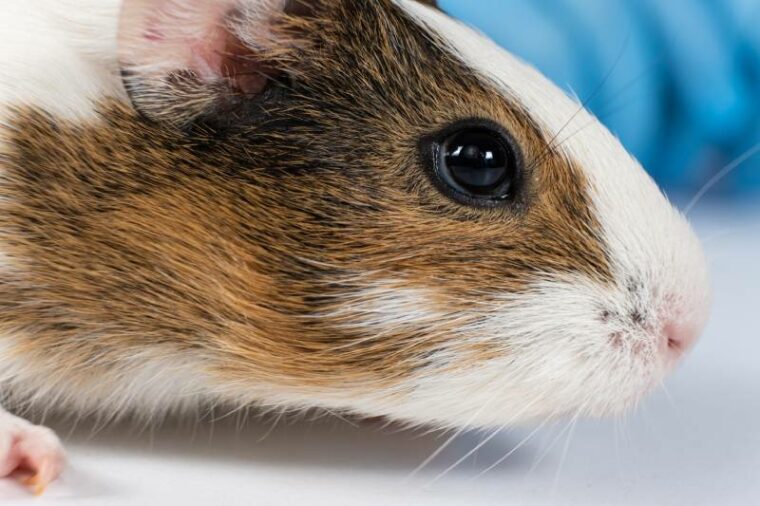
Click to Skip Ahead
Guinea pigs belong to the rodent order of mammals, along with rats, mice, rabbits, hamsters, and many other small toothy critters. Unlike rats and mice, guinea pigs are not nocturnal. They are crepuscular rodents that are most active at dusk and dawn. They are intermittently active during the remaining hours of the day and night. This has important implications for the structure and functioning of their eyes in comparison to other nocturnal rodents such as rats and mice.
Although guinea pigs possess dichromatic vision, the same as other rodents, some aspects of their eye structure and function are more comparable to the primates, including humans. To make them even more special, guinea pigs are born with open eyes and well-developed eye functionality, unlike humans.
Eye Structure and Function
Guinea pigs’ eyes work the same way as most other vertebrates. Light is focused onto the photoreceptors in the retina, at the back of the eye, by the lens, and then a message transmitted to the brain by the optic nerve is interpreted as an image.
The Cornea
In guinea pigs, light first passes through the cornea, which is the thickened transparent front part of the eyeball. The cornea’s two main functions include focusing light onto the lens and retina and protecting the eyeball’s more delicate inner structures. After passing through the cornea, light enters the inner eye through the pupil, which is a hole in the iris.
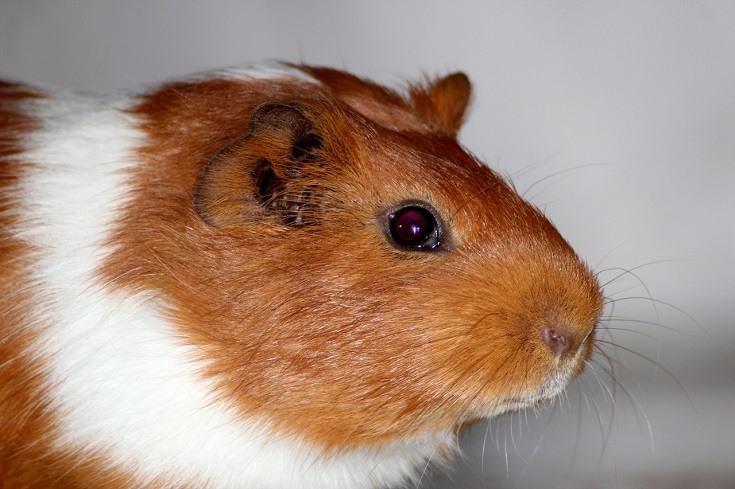
The Iris
The iris is the colored part of the eye. It can constrict or expand (dilate) to control the size of the pupil letting in less or more light in variable light conditions. In cavies, the iris is most commonly brown, black, ruby, dark, pink, and rarely blue.
The Retina
The adjustable disc-shaped lens sits behind the iris and focuses the light rays onto the retina at the back of the eye. The retina contains two types of photoreceptors: rods and cones.1 These cells are responsible for determining how well an animal perceives colors and how well they see in various light conditions. From here, messages are sent to the optic nerve, which travels to the brain as nerve impulses. These nerve impulses are converted to an image by the brain.

Field of Vision
Guinea pigs are prey animals characterized by having their eyes set on either side of their head. This is in contrast to predators that have their eyes facing forward. The placement of eyes on either side of the head provides a significant advantage in increasing an animal’s field of vision. This allows them to detect predators approaching from almost any direction. A guinea pig’s field of vision is an impressive 340 degrees.
They have two narrow blind spots: one directly in front of them and one directly behind them. They only need to make small head or body movements to compensate for these regions.
Depth Perception and Distance Vision
Guinea pigs do not have great depth perception due to their eyes being on either side of their head. Their sight is comparable to a short-sighted human. Because of their poor depth perception, they rely heavily on their other senses, which are highly developed and astute. The hairs on their muzzles, called vibrissae, are very helpful, for example, in measuring the width of openings, allowing them to move around easily in poor light conditions.
Color Vision
Guinea pigs have dichromatic vision, but the complete spectrum of color that guinea pigs can see is unclear. However, scientists have ascertained the presence of two types of cones in the guinea pigs’ retina, which positively confirms their ability to see color. Moreover, the type and number of cones in guinea pigs differ from that of other rodents, so it has been inferred that they may possess better color vision than their toothy brethren.
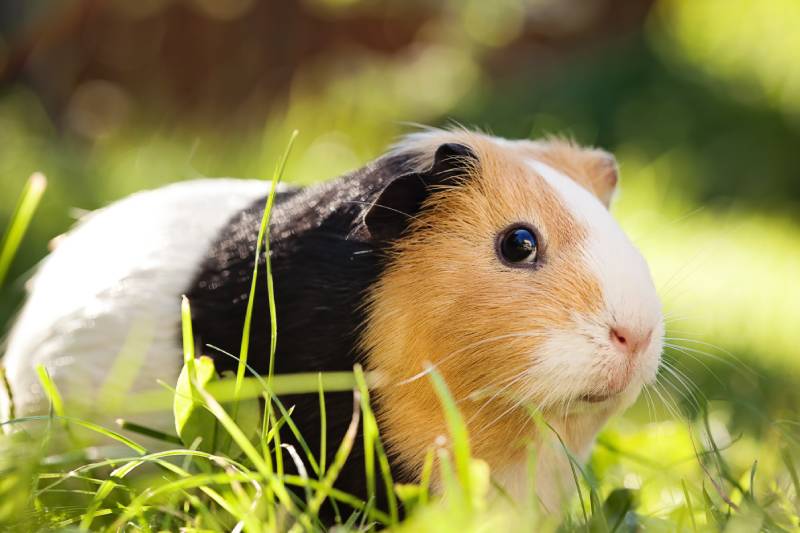
Night Vision
Although it may be intuitive to assume that guinea pigs can see well at night, that is not the case, like rats, mice, and some other rodents. Unlike some of their rodent counterparts, guinea pigs are not nocturnal and have not developed the ability to see well when it is dark.
When active at night, they use their other senses, such as smell and hearing, to move around effectively and safely. They also have very sensitive vibrissae on their face that can pick up how close to an object they are and what it is. The other superpower that cavies have is excellent spatial memory.
They can recall precisely the location of particular fixed objects around them, which helps them navigate in familiar environments even when they can’t see. This characteristic serves domesticated guinea pigs particularly well but may be less useful to wild guinea pigs with a more variable environment.
FAQs
Once you start delving into a topic, it’s not unusual to have more questions about it than you did at the beginning! Below we’ve answered some of the more frequently asked questions people have about guinea pigs’ eyes.
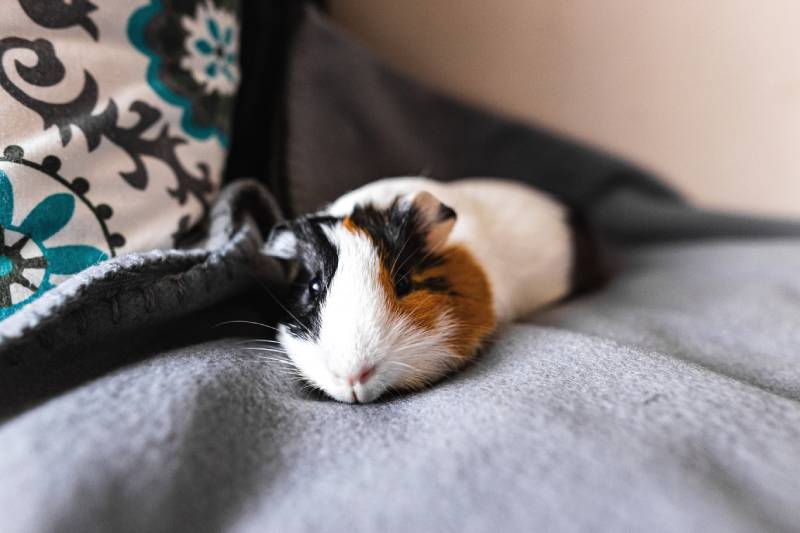
How Does a Guinea Pig’s Eyesight Affect Their Other Senses?
Since guinea pigs have relatively poor vision, some of their other senses are acutely developed. They have excellent hearing and smell to help them detect the presence of predators. They also have highly developed spatial reckoning and spatial memory. Sensitive whiskers on their face also help them navigate around objects in poor light conditions.
Do Guineas Pigs Blink?
Guinea pigs blink, but not very often; their blinking frequency has been calculated at 2 to 5 times every 20 minutes. They also don’t close their eyes frequently when compared to humans, dogs, and cats. You’re likely to miss it when they do blink since it is lightning fast—much faster than we blink. This is because, as prey animals, they must be on high alert at all times, and frequent or slow blinking will diminish their vigilance.
If your guinea pig blinks more often than usual, it could be a sign of a problem with their eyes. Under these circumstances, getting your little cavy checked out by your veterinarian as soon as possible is vital.
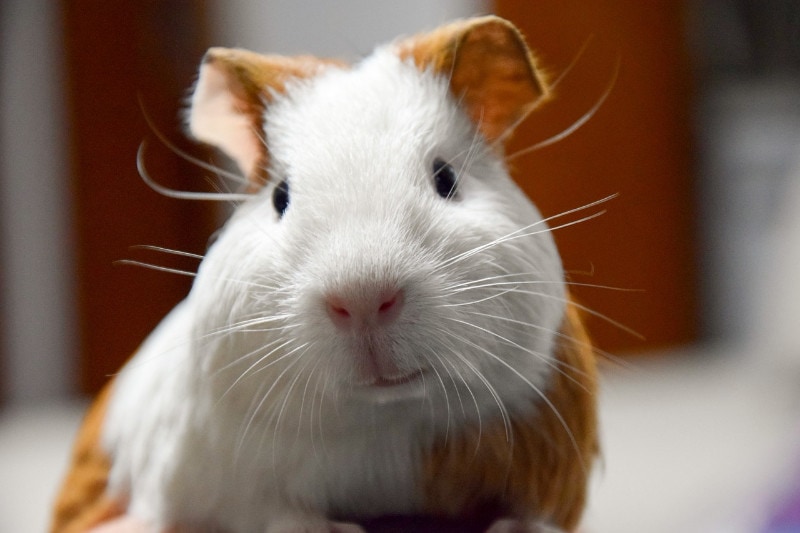
Do Guinea Pigs Close Their Eyes to Sleep?
Cavies are thought to only close their eyes to sleep if they are completely relaxed and trust their environment. It is possible to see them with their eyes closed, but not frequently. They nap on and off during each 24-hour period, attaining on average around 9 hours of light, semi-alert sleep in each cycle.
What’s The White Fluid In My Guinea Pig’s Eyes?
The white fluid that you see in your cavy’s eyes from time to time is completely normal. It is secreted and cleaned during their grooming process and helps lubricate their “unblinking” eyes. An excess of other fluids, such as a clear, weepy, or pussy discharge, is cause for concern and should be checked out by your veterinarian as soon as possible.

Are Guinea Pigs Prone to Eye Problems?
Guinea pigs are, unfortunately, prone to several eye issues, such as conjunctivitis (pink eye), corneal ulcers, eye infections, dry eye, and injuries from foreign objects that get trapped inside their eyes. These are usually plant materials from bedding or feeding.
It is essential to book an appointment with your vet whenever you notice any signs of eye problems in your guinea pig so that it does not turn into a bigger problem if left untreated.
Conclusion
It’s always beneficial to our beloved pets when we understand how their bodies and minds work and how they affect their behavior and functioning. Hopefully, this article has provided insight into how your cavy sees their world and how their eyes work.
A better understanding of their ocular physiology will help you provide an ideal habitat and environment for them. It should also help you to be on the lookout for any eye problems that may arise.
Featured Image Credit: Garna Zarina, Shutterstock








